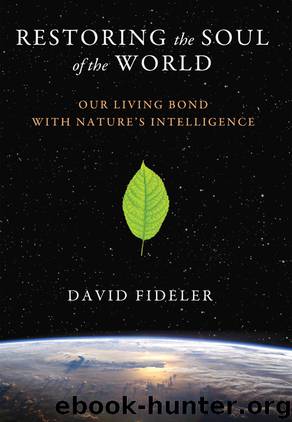Restoring the Soul of the World by David Fideler

Author:David Fideler
Language: eng
Format: epub
Tags: Spirituality/Science and Nature
Publisher: Inner Traditions / Bear & Company
Published: 2014-11-02T00:00:00+00:00
NATURE’S IMAGINATION
Previous to Freud the great explorers and theorists of the unconscious were the Romantic philosophers and poets. The Romantics rebelled against the suffocating reductionism of the mechanical philosophy which taught that the universe was dead and that essential human nature was nothing more than a disembodied intellect. For the Romantics, humanity existed in nature, but nature also existed in humanity. The locus and meeting point of human nature and universal nature was the unconscious. While the unconscious itself cannot be visualized, its energies and creative powers can be directly experienced. Through the faculty of the imagination, humanity taps into the creative, form-giving power that shapes the universe and all living phenomena. Nature itself is a dynamic unfolding power, yet it is also a power manifest in the human psyche. Deep within our being, our innermost nature is nature itself. According to the Romantics, the unconscious is the point of contact that links the individual with the creative forces of the universe.
Not only did the Romantic view stand in sharp opposition to Descartes, it also opposed the fundamental dualism of Immanuel Kant (1724–1804), the greatest of the modern philosophers. While Descartes’ dualism separated humanity from the world by saying that mind and matter were inherently different realities that could never meet, Kant’s dualism embodied a form of intellectual skepticism in which the rational mind could never know the true nature of reality. According to Kant, the world is never given to human perception as it really is because the human mind always shapes reality according to preexisting or a priori categories of thought. For Kant, there was a clear and sharp distinction between the phenomenal world that we experience and the noumenal world as it really is, which forever lies beyond our grasp. If the Copernican revolution had removed humanity from the center of the universe, Kant’s philosophy implied an even greater alienation by suggesting that we cannot even rationally know the true nature of reality.
Yet perhaps in all of this the trouble is with the limited nature of rationality. Plato saw reason as a useful tool, but two thousand years before Kant had pointed out its limitations as a way of knowing. Reason holds the world at an arm’s length and something higher or deeper is needed to contact and nonverbally experience the world in profundity. While Descartes had stressed the sharp difference between inner and outer worlds and Kant had stressed the unknowability of the world “in itself ” apart from the imposed constructions of the mind, the Romantics stressed the congruence of inner and outer reality. Rebuffing the Kantian-like idea of alienation, William Wordsworth proclaimed his “high argument”:
How exquisitely the individual Mind
. . . to the external World
Is fitted:—and how exquisitely, too—
Theme this but little heard of among men—
The external World is fitted to the Mind . . .14
For the Romantics, we can know and experience the world in deeply intimate ways because “inner” and “outer” are just different aspects of one creative activity. The Romantics revived
Download
This site does not store any files on its server. We only index and link to content provided by other sites. Please contact the content providers to delete copyright contents if any and email us, we'll remove relevant links or contents immediately.
Becoming Supernatural by Dr. Joe Dispenza(8119)
Crystal Healing for Women by Mariah K. Lyons(7855)
The Witchcraft of Salem Village by Shirley Jackson(7189)
Inner Engineering: A Yogi's Guide to Joy by Sadhguru(6725)
The Four Agreements by Don Miguel Ruiz(6630)
The Power of Now: A Guide to Spiritual Enlightenment by Eckhart Tolle(5605)
Secrets of Antigravity Propulsion: Tesla, UFOs, and Classified Aerospace Technology by Ph.D. Paul A. Laviolette(5309)
The Wisdom of Sundays by Oprah Winfrey(5086)
Room 212 by Kate Stewart(5035)
Pale Blue Dot by Carl Sagan(4912)
Fear by Osho(4660)
The David Icke Guide to the Global Conspiracy (and how to end it) by David Icke(4625)
Animal Frequency by Melissa Alvarez(4395)
Rising Strong by Brene Brown(4377)
How to Change Your Mind by Michael Pollan(4292)
Sigil Witchery by Laura Tempest Zakroff(4180)
Real Magic by Dean Radin PhD(4073)
Man and His Symbols by Carl Gustav Jung(4067)
The Art of Happiness by The Dalai Lama(4063)
